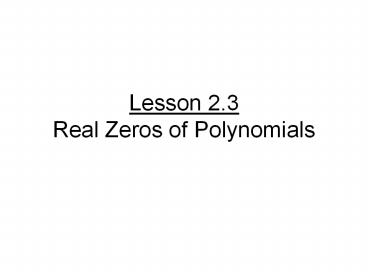Lesson 2.3 Real Zeros of Polynomials - PowerPoint PPT Presentation
1 / 15
Title:
Lesson 2.3 Real Zeros of Polynomials
Description:
Lesson 2.3 Real Zeros of Polynomials Lesson 2.3 Real Zeros of Polynomials The Division Algorithm Dividing by a polynomial Set up in long division 2 terms in ... – PowerPoint PPT presentation
Number of Views:177
Avg rating:3.0/5.0
Title: Lesson 2.3 Real Zeros of Polynomials
1
Lesson 2.3Real Zeros of Polynomials
2
The Division Algorithm
3
Dividing by a polynomial Set up in long
division
2 terms in divisor (x 1). How does this go into
1st two terms in order to eliminate the 1st term
of the dividend.
2x
1
- Multiply by the divisor
- Write product under dividend
- Subtract
- Carry down next term
- Repeat process
2x2 2x
-
-
x 5
x 1
-
-
4
Answer
4
HINTS If a term is missing in the dividend add
a 0 term. If there is a remainder, put it over
the divisor and add it to the quotient (answer)
Example 1 (x4 x2 x) (x2 - x 1)
5
- Synthetic Division
- Less writing
- Uses addition
- Setting Up
- Divisor must be of the form x a
- Use only a and coefficients of dividend
- Write in zero terms
x 2 a 2 x 3 a -3
4 5 0 -2 5
6
4 5 0 -2 5
7
- Steps
- Bring down
- Multiply diagonally
- Add
- Remainder last addition
- Answer
- Numbers at bottom are coefficients
- Start with 1 degree less than dividend
REPEAT
8
Example 2 (2x3 7x2 11x 20) (x 5)
9
Example 3 (2x4 30x2 2x 1) (x 4)
Problem Set 2.3 (1 21 EOO)
10
The Remainder Theorem If f(x) is divided by x
a , the remainder is r f(a)
The Factor Theorem If f(x) has a factor (x a)
then f(a) 0
11
Example 4 Show that (x 2) and (x 3) are
factors of
12
Rational Zero Test Every rational zero
Factors of constant term
Factors of leading coefficient
13
Descartes Rule Number of positive real roots
is ? the number of variations in the signs,
or ? less than that by a positive even
integer 5x4 3x3 2x2 7x
1 variations possible positive real roots
14
(No Transcript)
15
Example 5 List possible zeros, verify with your
calculator which are zeros, and check results
with Descartes Rule
Problems Set 2.3

